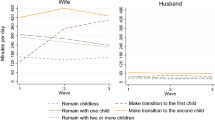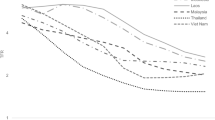Abstract
With the growing prevalence of the dual-earner family model in industrialized countries the gendered nature of the relationship between employment and parenting has become a key issue for childbearing decisions and behavior. In such a context taking into account the societal gender structure (public policies, family-level gender relations) explicitly can enhance our understanding of contemporary fertility trends. In this paper we study the second birth, given its increasing importance in the developed world as large proportions of women remain childless or bear only one child. We focus on Sweden where gender equality is pronounced at both the societal and the family level and on Hungary where the dual-earner model has been accompanied by traditional gender relations in the home sphere. Our analysis is based on data extracted from the Swedish and Hungarian Fertility and Family Surveys of 1992/93. We use the method of hazard regression. The results suggest that the second-birth intensity increases as the combination of parenthood and labor-force attachment of either parent is facilitated. We see this in the effect of family policies in Sweden and in the higher second-birth intensity of couples who share family responsibilities as compared to those with traditional gender-role behavior in both countries. Also, the lack of any visible impact of men's educational attainment in both Sweden and Hungary is probably linked to public policies as state support for families with children has reduced the importance of income for second childbearing. A positive educational gradient for Swedish women and an essentially zero gradient in Hungary reflects the success of policy measures in reducing fertility cost for more educated women in both countries.
Similar content being viewed by others
References
Adamik, M. (1991), Hungary - Supporting parenting and child rearing: Policy innovation in Eastern Europe, pp. 115–144 in S.B. Kamerman & A.J. Kahn (eds.), Child care, parental leave, and the under 3s: Policy innovation in Europe. New York: Auburn House.
Andersson, G. (1999), Childbearing trends in Sweden 1961–1997, European Journal of Population 15(1): 1–24.
Andorka, R. (1994), Magyarország a társadalmi jelzöszámok idösorainak tükrében (Hungary - as reflected in the time series of societal measurements), pp. 11–33 in R. Andorka, T. Kolosi & Gy. Vukovich (eds.), Társadalmi riport, 1994. (Social Report, 1994) Budapest: TÁRKI.
Becker, G. S. (1991), A Treatise on the Family, Cambridge, MA: Harvard University Press. Enlarged edition.
Bergqvist, C. & Nyberg, A. (2002), Welfare state restructuring and child care in Sweden, pp. 287–307 in S. Michel & R. Mahon (eds.), Child care policy at the crossroads. Gender and welfare state restructuring. New York, London: Routledge.
Bernhardt, E.M. (1993), Fertility and employment, European Sociological Review 9(1): 25–42.
Brewster, K.L. & Rindfuss, R.R. (2000), Fertility and women's employment in industrialized nations, Annual Review of Sociology 26: 271–296.
Chesnais, J.-C. (1996), Fertility, family, and social policy in contemporary Western Europe, Population and Development Review 22(4): 729–739.
Council of Europe. (1999), Recent demographic developments in Europe, Strasbourg: Council of Europe Press.
Ferge, Zs. (1985), Biologikum és nemek közötti egyenlöség (Biology and gender equality), in K. Koncz (ed.), Nök és Férfiak. Hiedelmek, Tények. (Women and Men. Beliefs and Facts), Budapest: Kossuth.
Frejka, T. & Ross, J. (2001), Paths to subreplacement fertility: The empirical evidence, Population and Development Review, Supplement to Vol. 27, Global Fertility Transition, pp. 213–254.
Granström, F. (1997), Fertility and Family Surveys in Countries of the ECE Region. Standard Country Report. Sweden. New York and Geneva: United Nations.
Gustafsson, S. & Stafford, F.P. (1994), Three regimes of childcare: the United States, the Netherlands and Sweden, pp. 333–361 in R.M. Blank (ed.), Social protection versus economic flexibility: Is there a trade-off? Chicago: University of Chicago Press.
Haas, L. (1992), Equal Parenthood and Social Policy. A study of parental leave in Sweden, Albany: State University of New York Press.
Hobson, B. (ed.) (2002), Making men into fathers. Men, masculinities and the social politics of fatherhood. Cambridge: Cambridge University Press.
Hoem, B. (1996a), Some features of recent demographic trends in Sweden, Stockholm Research Reports in Demography No. 104, Stockholm: Stockholm University.
Hoem, B. (1996b), The social meaning of the age at second birth for third-birth fertility: A methodological note on the need to sometimes respecify an intermediate variable, Yearbook of Population Research in Finland 33: 333–339.
Hoem, B. & Hoem, J. M. (1989), The impact of women's employment on second and third births in modern Sweden, Population Studies 43(1): 47–67.
Hoem, J.M. (1993), Public policy as the fuel of fertility: Effects of a policy reform on the pace of childbearing in Sweden in the 1980s, Acta Sociologica 36(1): 19–31.
Joshi, H. (1998), The opportunity costs of childbearing: More than mothers’ business, Journal of Population Economics 11(2): 161–183.
Kamarás, F. (1999), Fertility and Family Surveys in Countries of the ECE Region. Standard Country Report. Hungary. New York and Geneva: United Nations.
Klinger, A. (1991), Magyarország demográfiai helyzete Eurćpában. (The demographic situation of Hungary in Europe), Demográfia 34(1–2): 19–60.
Lehrer, E. & Nerlove, M. (1986), Female labor force behavior and fertility in the United States, Annual Review of Sociology 12: 181–204.
Lesthaeghe, R. & Willems, P. (1999), Is low fertility a temporary phenomenon in the European Union? Population and Development Review 25(2): 211–228.
Oláh, L.Sz. (1998), ‘Sweden, the middle way’: A feminist approach, The European Journal of Women's Studies 5(1): 47–67.
Oláh, L.Sz. & Fratczak, E. (2002), Gendering family formation: Firstmarriage and first birth in Hungary and Poland. Paper presented at the 15th World Congress of Sociology, Brisbane, Australia, 7–13 July, 2002.
Oppenheimer, V.K. (1995), The role of women's economic independence in marriage formation: A skeptic's response to Annemette Sorensen's remarks, pp. 236–243 in H.-P. Blossfeld (ed.), The new role of women: Family formation in modern societies. Boulder, San Francisco: Westview Press.
Oppenheimer, V.K. (1994), Women's rising employment and the future of the family in industrial societies, Population and Development Review 20(2): 293–342.
Panayotova, E. & Brayfield, A. (1997), National context and gender ideology. Attitudes toward women's employment in Hungary and the United States, Gender & Society 11(5): 627–655.
Presser, H.B. (2001), Comment: A gender perspective for understanding low fertility in post-transitional societies, Population and Development Review, Supplement to Vol. 27, Global Fertility Transition, pp. 177–183.
Presser, H.B. (1986), Comment, Population and Development Review, Supplement to Vol. 12, Below-Replacement Fertility in Industrial Societies: Causes, Consequences, Policies, pp. 196–200.
Rindfuss, R.R. & Brewster, K.L. (1996), Childrearing and fertility, Population and Development Review, Supplement to Vol. 22, Fertility in the United States: New Patterns, New Theories, pp. 258–289.
Rindfuss, R.R., Morgan, S.P. & Swicegood, G. (1988), First Births in America. Berkeley, Los Angeles: University of California Press.
Robinson, W.C. (1997), The economic theory of fertility over three decades, Population Studies 51(1): 63–74.
Sainsbury, D. (1996), Gender, Equality and Welfare States, Cambridge: Cambridge University Press.
Sándorné Horváth, E. (1986), A GYEStöl a GYEDig, (From Childcare Allowance “GYES” to Childcare Pay “GYED”) Budapest: Kossuth.
Santow, G. & Bracher, M. (2001), Deferment of the first birth and fluctuating fertility in Sweden, European Journal of Population 17(4): 343–363.
Schultz, T.P. (1981), Economics of Population, Reading, MA: Addison-Wesley.
Stafford, F.P. & Sundström, M. (1996), Time-out for childcare: Signalling and earnings rebound effects for men and women, Labour 10(3): 609–629.
Sundström, M. (1991), Sweden: Supporting work, family and gender equality, pp. 171–199 in S.B. Kamerman & A.J. Kahn (eds.), Child care, parental Leave and the under 3s. Policy innovation in Europe. New York: Auburn House.
Sundström, M. (1993), The growth in full-time work among Swedish women in the 1980s, Acta Sociologica 36(2): 139–150.
Sundström, M. & Duvander, A.-Z. (1999), Family division of child care: Why do - or don't - Swedish fathers take parental leave? Stockholm Research Reports in Demography No. 139, Stockholm: Stockholm University.
Szalai, J. (1991), Some aspects of the changing situation of women in Hungary, Signs: Journal of Women in Culture and Society 17(1): 152–170.
Author information
Authors and Affiliations
Rights and permissions
About this article
Cite this article
Oláh, L.S. Gendering fertility: Second births in Sweden and Hungary. Population Research and Policy Review 22, 171–200 (2003). https://doi.org/10.1023/A:1025089031871
Issue Date:
DOI: https://doi.org/10.1023/A:1025089031871




